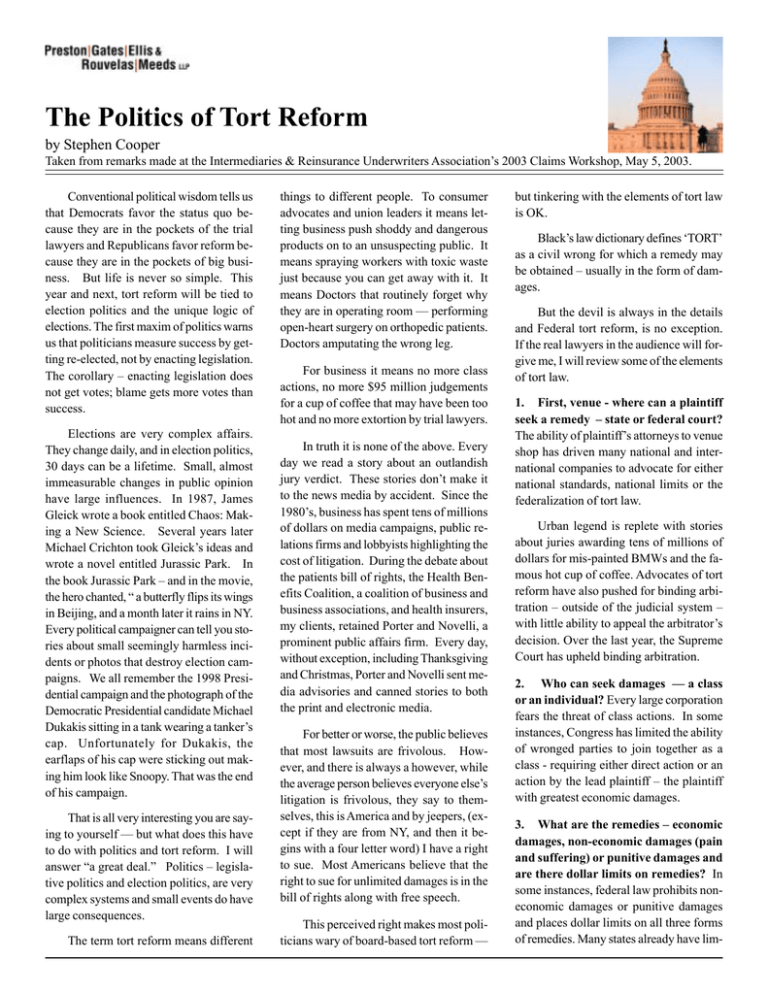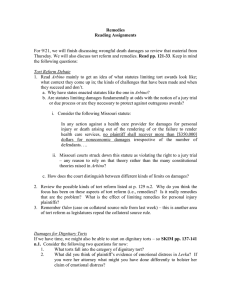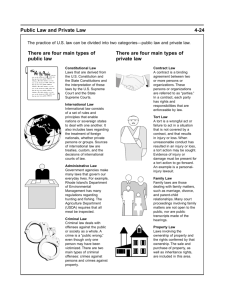Conventional political wisdom tells us
advertisement

The Politics of Tort Reform by Stephen Cooper Taken from remarks made at the Intermediaries & Reinsurance Underwriters Association’s 2003 Claims Workshop, May 5, 2003. Conventional political wisdom tells us that Democrats favor the status quo because they are in the pockets of the trial lawyers and Republicans favor reform because they are in the pockets of big business. But life is never so simple. This year and next, tort reform will be tied to election politics and the unique logic of elections. The first maxim of politics warns us that politicians measure success by getting re-elected, not by enacting legislation. The corollary – enacting legislation does not get votes; blame gets more votes than success. Elections are very complex affairs. They change daily, and in election politics, 30 days can be a lifetime. Small, almost immeasurable changes in public opinion have large influences. In 1987, James Gleick wrote a book entitled Chaos: Making a New Science. Several years later Michael Crichton took Gleick’s ideas and wrote a novel entitled Jurassic Park. In the book Jurassic Park – and in the movie, the hero chanted, “ a butterfly flips its wings in Beijing, and a month later it rains in NY. Every political campaigner can tell you stories about small seemingly harmless incidents or photos that destroy election campaigns. We all remember the 1998 Presidential campaign and the photograph of the Democratic Presidential candidate Michael Dukakis sitting in a tank wearing a tanker’s cap. Unfortunately for Dukakis, the earflaps of his cap were sticking out making him look like Snoopy. That was the end of his campaign. That is all very interesting you are saying to yourself — but what does this have to do with politics and tort reform. I will answer “a great deal.” Politics – legislative politics and election politics, are very complex systems and small events do have large consequences. The term tort reform means different things to different people. To consumer advocates and union leaders it means letting business push shoddy and dangerous products on to an unsuspecting public. It means spraying workers with toxic waste just because you can get away with it. It means Doctors that routinely forget why they are in operating room — performing open-heart surgery on orthopedic patients. Doctors amputating the wrong leg. For business it means no more class actions, no more $95 million judgements for a cup of coffee that may have been too hot and no more extortion by trial lawyers. In truth it is none of the above. Every day we read a story about an outlandish jury verdict. These stories don’t make it to the news media by accident. Since the 1980’s, business has spent tens of millions of dollars on media campaigns, public relations firms and lobbyists highlighting the cost of litigation. During the debate about the patients bill of rights, the Health Benefits Coalition, a coalition of business and business associations, and health insurers, my clients, retained Porter and Novelli, a prominent public affairs firm. Every day, without exception, including Thanksgiving and Christmas, Porter and Novelli sent media advisories and canned stories to both the print and electronic media. For better or worse, the public believes that most lawsuits are frivolous. However, and there is always a however, while the average person believes everyone else’s litigation is frivolous, they say to themselves, this is America and by jeepers, (except if they are from NY, and then it begins with a four letter word) I have a right to sue. Most Americans believe that the right to sue for unlimited damages is in the bill of rights along with free speech. This perceived right makes most politicians wary of board-based tort reform — but tinkering with the elements of tort law is OK. Black’s law dictionary defines ‘TORT’ as a civil wrong for which a remedy may be obtained – usually in the form of damages. But the devil is always in the details and Federal tort reform, is no exception. If the real lawyers in the audience will forgive me, I will review some of the elements of tort law. 1. First, venue - where can a plaintiff seek a remedy – state or federal court? The ability of plaintiff’s attorneys to venue shop has driven many national and international companies to advocate for either national standards, national limits or the federalization of tort law. Urban legend is replete with stories about juries awarding tens of millions of dollars for mis-painted BMWs and the famous hot cup of coffee. Advocates of tort reform have also pushed for binding arbitration – outside of the judicial system – with little ability to appeal the arbitrator’s decision. Over the last year, the Supreme Court has upheld binding arbitration. 2. Who can seek damages — a class or an individual? Every large corporation fears the threat of class actions. In some instances, Congress has limited the ability of wronged parties to join together as a class - requiring either direct action or an action by the lead plaintiff – the plaintiff with greatest economic damages. 3. What are the remedies – economic damages, non-economic damages (pain and suffering) or punitive damages and are there dollar limits on remedies? In some instances, federal law prohibits noneconomic damages or punitive damages and places dollar limits on all three forms of remedies. Many states already have lim- its on non-economic damages and punitive damages. For example, the state of Virginia has an across the board $250,000 limit on punitive damages. 4. When does an injury occur? Does an injury occur at the time of the incident or when it becomes manifest – oftentimes many years later. Many states have statutes of limitations – establishing a time limit for suing in a civil case. However the harm from asbestos exposure or other toxic substances may not become apparent for many years. Faced with state statutes of limitations, many attorneys file premature claims prior to the manifestation of injury. The compromise asbestos litigation reform bill now under discussion will probably propose a liberalization or extension of the statute of limitations for asbestos cases. 5. How do you define wrong or as a colleague of mine would say, how wrong was wrong? Black’s Law dictionary lists literally dozens of different types of negligence - from simple negligence, negligence in which the individual is unaware of the risk he or she created, to gross negligence — a conscious disregard of the consequences to another individual. I am not sure that all of these definitions help define degrees of negligence — is reckless negligence worse than gross negligence, is it worse than wanton negligence? During last year’s debate about the Patients Bill of Right, the Democrats and Republicans argued about the standard allowing a subscriber to bring an action against a health plan. The Democrats wanted ordinary negligence – something more than simple negligence but less than gross negligence. The Republicans advocated gross negligence. 6. What are the rules of evidence? During the debate over the Patient Bill of Rights, advocates for insurers and business argued that plaintiffs should not be able to submit any evidence in a judicial proceeding that they didn’t present during an administrative review. Advocates for Tort Reform would like to limit the “fishing expeditions” the discovery process afforded plaintiff’s attorneys. In asbestos litigation, in some instances before that individual is eligible to participate in an class action, an independent reviewer must certify that a claimant has suffered injury from exposure to asbestos. However, the independent reviewer’s findings may not be presented as evidence. 7. Who is liable? We have all heard the term, joint and several liability. This rule allows any defendant in a case to be held liable for the entire amount of the claim regardless of fault. Advocates of tort reform argue for proportional liability. 8. How are damages awarded? In many instances, courts award damages as a lump sum. Advocates of tort reform have advocated for structured settlements – consisting of periodic payments over time. 9. Attorney’s fees and the contingency fees. Most attorneys charge clients on a contingency basis – that is a fixed percentage of the damages award – generally ranging from 33% to 50%. Advocates of tort reform would like to limit attorney’s fees to either a fixed dollar amount or to a smaller percentage – from 15% to 25%. To avoid confusion, I will define tort reform as a measure addressing any or all of the nine elements listed above. Will federal tort reform pass this year? Broad based federal tort reform will not pass this year. However, every year, and this year is no exception, Congress enacts and the President signs legislation addressing one or more of the nine elements. On April 30, last Wednesday, President Bush signed a bill, HR 1770, providing compensation to health care workers and other workers injured as a result of receiving a small pox vaccination. Under this bill permanently disabled individuals can receive as much as $50,000 a year for life in lost wages and spouses of individuals killed by the vaccine can receive a lump sum settlement of $262,100. Those dissatisfied with their compensation can file suit under the Federal Torts Claims Act. Why is this tort reform…..it addresses venue, who can seek damages, types of damages, places economic limits on damages, defines injury, who is liable or this case not liable, defines wrong doing, method of payment and attorney’s fees. In general, Congress is more likely to enact tort reform when there is a national priority, a clear national interest or a crisis. The former Counsel to the US Senate, Bill Diefenderfer, would say “the Congress passes legislation when faced with crisis or Christmas. I would argue that the urge to leave Washington for the Christmas holiday is generally a more powerful motive than crisis, but nonetheless crisis is ample motivation. For example, in 1957 Congress passed the Price Anderson Act limiting the liability of the nuclear industry in the event of a nuclear accident. We were in the middle of the cold war, the unsettled mid-eastern political environment threatened oil shipments and Congress believed that the development of a nuclear power industry was critical to the safety and economic well being of the country. Companies were adamant that without some legal protections they would not engage in this business. Before a Congressional Committee Charles Weaver, a vice president of Westinghouse, stated: “we cannot risk the financial stability of our company for a relatively small project no matter how important it is to the country’s reactor development effort, if it could result in a major liability in relation to our assets.” Without trying to sound too cynical, since the 1950’s, every special interest has argued that tort reform for them is of national importance. Forget broad based tort reform, they say, help us. Tax lobbyist have the saying – “don’t tax me, don’t tax thee, tax the fellow behind the tree.” We can easily change that to – “don’t sue me, don’t sue thee, sue the fellow behind the tree.” While there has been a great deal of discussion about broad-based tort reform, in truth, no one believes it will happen any time soon. Like tax lobbying, it has become every group for itself. This year, physicians have made malpractice reform their top priority. Physicians have held demonstrations in state capitols, threatened to quit medicine and have turned on their powerful media machine telling us we face a national crisis. While a bill did pass the House, HR 5, it is unlikely to pass through the Senate. First, it is not clear that this is a national issue. Health care is local; most patients do not cross state lines to see a physician. Second, states have the ability to limit malpractice claims and many have. And a number of Republicans have expressed concerns about setting federal limits on state courts. Third, the evidence is not so clear. Some studies have shown that malpractice insurance premiums in states having enacted tort reforms are no less than premiums in states without limits. In addition, many of the malpractice carriers have said that new federal limits will not result in lower premiums. Fourth, while physicians have done a good job rallying public support, the House bill extends these limits to drug companies, medical device manufacturers and health plans. Senate Democrats and a number of Senate Republicans are not sure they want to go that far. Fifth, and most important, it is not clear that the Republicans really want to pass malpractice reform. Under the rules of the Senate, 60 Senators must agree to allow a bill to come to the floor for a vote. The Republicans do not have 60 votes and, in all likelihood, this bill will not come up for a vote. There is this growing suspicion that the Republicans would be just as happy not bringing this bill up for a vote – and blaming the Democrats for blocking physician malpractice reform. Remember, in politics, blame is a more powerful force than accomplishment. The Senate is now working towards class action reform – S 274, S 274 would move more class actions to federal courts – limiting venue shopping and making it more difficult for some class members to receive disproportionate benefits. Again it is unclear that the more ideological House will accept a moderate Senate bill. And again, Republicans will have to make a judgment if no bill is better for fundraising and election politics than a compromise bill. This year, Congress may be able to enact asbestos litigation reform. Spanning 30 years, asbestos litigation is probably the longest running mass tort in US history. Over the last two years, there have been over 200,000 new asbestos lawsuits. ERISA. ERISA was suppose to pre-empt state law, prohibit class actions, limit claims to no more than the value of the benefit and limit claims to federal court. Why now? The current system of lawsuits doesn’t help anyone. It doesn’t protect workers exposed to asbestos and it doesn’t protect business. Facing large asbestos claims over 70 companies have already filed for bankruptcy. Under the current system, many of those sick or dying from asbestos exposure will receive little or nothing if they filed a claim against a company already in bankruptcy. Workers exposed to asbestos but not ill may be forced to file a claim prematurely. And if the claim is made against a financially solvent company they may receive compensation. And business faced with a growing number of cases, would like to see a settlement. AND most important there is no political gain in blocking asbestos litigation reform. Why compromise now — everyone wins something. The courts have routinely allowed the states, health care providers and subscribers seek remedies in state courts, bring class actions and seek both non-economic and punitive damages. The proposed Senate compromise involves the creation of a trust fund. The unanswered questions are –how large a trust fund, will there be any public money in the trust funds, how much would insurers and business each pay into the trust fund and could some businesses opt-out of the participating in the fund? Which leads us back to Jurassic Park and dinosaurs. In Jurassic Park, the dinosaurs escape and the hero tells us that the dinosaurs will always escape. Well tort reform is like Jurassic Park. The dinosaurs will always escape. The compromise Asbestos bill will probably allow some companies to opt-out of the trust funds. Companies opting out will those companies or industries believing judicial settlements will be less costly than paying in to a new trust fund. Every insurance company knows that pools of this sort only work when you can spread the risk. If individuals or companies with less risk can opt out, an insurance company or public trust fund will soon find itself in the classic insurance death spiral. In the past and I suspect in the future the Courts will let the some of the dinosaurs escape. We only have to look at After Congress enacts tort reform, physician malpractice reform or asbestos litigation reforms, very smart lawyers from around the country will find exceptions, and soon these exceptions will become the rule. Why is tort reform a national issue? The quick answer is John Edwards, Senator from North Carolina, a Presidential hopeful and a trial lawyer. The White House needs a bogeyman. They have painted John Edwards and the democrats as tools of the trial bar - destroying health care for America. If John Edwards drops out of the race, which could easily happen, tort reform may no longer be the darling of the Republicans. I am suppose to make predictions about the 2004 Presidential race, which party will control the Senate and the House in 2005 and who will win the world series. I am not going to. Politics is about change. James Gleick said that we have all these fancy high-powered computers to predict the weather but a butterfly flaps her wings in Beijing and a month later it rains in NY. Small almost immeasurable changes have large influences. Stephen Cooper is a Government Affairs Counselor at the law and lobbying firm Preston Gates Ellis & Rouvelas Meeds LLP in Washington DC. Mr. Cooper focuses his practice on federal policy, health care, health information & health technology. For more information, visit www.pgerm.com.







